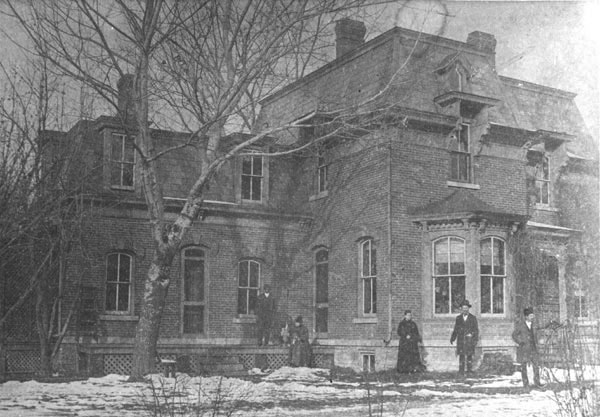|
|
James R. Mead Residence
|
Editor’s Note: All information comes from the Tihen notes at WSU. Even the newspaper quotes are those which Mr. Tihen put in quote marks.
James R. Mead built one of the first brick houses in Wichita, with its ground-breaking in October 1872.
The home was a gift for his new bride who had come to Wichita from St. Joseph as Lucy Inman with her sister, Mrs. William Mathewson, in 1869. She married J. R. Mead in 1872.
A January 1874 Beacon article included the Mead residence as part of a description of Lumberman’s Row, on north Lawrence and said the residence cost $10,000.
By comparison, just across Central to the north, stood the brick home of J.C. Fraker, the first vice-president of the new "Board of Trade of the city of Wichita, Kansas," which only cost $6,000.
The Meads moved into the home in the spring of 1873. The home faced Topeka, and the view would have been beautiful because it was surrounded by trees.
In fact, Mead was such a proponent of trees that he offered to give free trees to every resident of the Mead addition if they would plant and take care of them.
The offer paid off as a May 1873 Eagle article notes that "hundreds, yes, thousands of trees have been transplanted in Wichita this spring, especially on both sides of Emporia, Lawrence and Topeka avenues, in Mead’s addition."
However progress imposed itself on the arbor when the city improved Central Avenue. In the process of widening the street, Mead’s "row of fine cottonwood trees, which were fully 12 feet from the edge of the sidewalk," were cut down.
The Meads lived in their fine stone home for 20 years, but in January 1893 they sold their property to J.T. Ludlum, who immediately sold it to the Right Reverend John J. Hennessey, bishop, for $24,000.
An interview with Father Tihen, pastor of the pro-cathedral parish, indicated that the location was to be used as the site for a new cathedral for Wichita.
And, by August 1893, Father Tihen and his assistant, Father Martin, were living in the residence recently vacated by Mr. Mead "in cathedral square." The Eagle article adds, "It is furnished nicely and both gentlemen like the change very much."
In the meantime, Mead was improving property on Wabash Avenue, between Third and Central, where he planned to move.
Mrs. Mead did not get to enjoy her new home, as she died on Feb. 24, 1894 in St. Joseph, her old home town.
Ground breaking for the new Cathedral took place April 8, 1906 with an Eagle article stating, "The previous plan of having it face west on Lawrence avenue has been changed, and it will now face north on Central avenue. This removes the necessity of tearing down the old brick Mead house on Central half way between Lawrence and Topeka, which will continue to be used by the church."
James R. Mead died March 31, 1910 at the age of 74, and a family mausoleum was built in Maple Grove cemetery of granite from Barre, Vermont.
The Mead home survived another 13 years but was torn down in 1923 to make room for a new cut stone rectory for the Cathedral.
That 2-storey structure of Bedford stone was estimated to cost $90,000 and still stands today.
Wichita’s Historic Preservation Board erected a sign in front of the rectory in 1994 which reads:
James R. Mead: A Wichita Leader
In 1863, Mead came to the junction of the Arkansas Rivers as a successful hunter. Mead was instrumental in the prosperity of Wichita as a cattle town. As one of the "Four Horsemen," the first herd coming north in 1865 was intercepted. When they couldn’t convince them to come to Wichita via the Chisholm Trail, they bribed them, setting precedent for all other herds that year! In 1868, Mead helped form the Wichita Town Company, and after much debate, he chose to name it after the Wichita Indians. Mead knew the importance a railroad would make, so to attract attention from the Santa Fe Railroad, he created the Wichita and Southwestern (W&SW) and donated land for the tracks. Mead believed that "cities are not the result of chance, nor do they make themselves. Their prosperity and greatness are . . . due to the sagacity and enterprise of their founders and early settlers in reaching out and drawing to them the channels of commerce and trade." Mead built his first house (no longer standing) at 307 E. Central in 1872, and it was the first brick house to have a built-in bathtub.
10/10/2010
